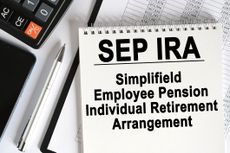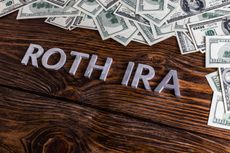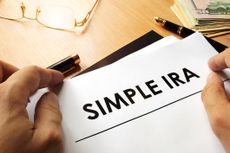Simple Investing Is Smart Investing
You don’t need an MBA to reach your financial goals. We show you how to make money the easy way.

Want to be the next Warren Buffett? You could begin by clearing your schedule, buying some highlighters, poring over annual reports and hitting the 800-page tome Security Analysis. And that’s just for starters. Want to be simply a great investor? Then learn to invest simply.
The big secret to successful investing is that it’s actually not all that complicated. Most of the mumbo jumbo doesn’t matter. You don’t need to know the difference between a credit-default swap and a credit card, or between a convertible bond and a convertible sofa, to manage your own money. Common sense will get you further than an MBA.
Investors often sabotage their results when they try to get fancy. “When investors tinker, they tend to buy things after they’ve gone up and sell things after they’ve gone down, which is a terrible way to manage a portfolio,” says David Swensen, manager of Yale University’s $19.4 billion endowment and author of Unconventional Success: A Fundamental Approach to Personal Investment. Over the past ten years, for example, mutual fund investors have cost themselves an average of two percentage points per year by buying high and selling low, according to fund tracker Morningstar. Perhaps we would mend our ways if we could more easily see evidence of how much our follies cost. But complex investing often means cluttered accounts, and it’s difficult to tell what your actual return is when your portfolio is a messy menagerie.

Sign up for Kiplinger’s Free E-Newsletters
Profit and prosper with the best of expert advice on investing, taxes, retirement, personal finance and more - straight to your e-mail.
Profit and prosper with the best of expert advice - straight to your e-mail.
Among the few things that an investor can predict in advance are costs. “There’s only one thing about investing that I am absolutely sure of: The lower the expense that I pay to the purveyor of an investment service, the more money there will be for me,” says Burton Malkiel, professor of economics at Princeton University and author of A Random Walk Down Wall Street.
Consider this example. Suppose you’re preparing for retirement by saving $10,000 a year over the next three decades. Assuming your portfolio averages an 8% annual return before fees, you would retire with a nest egg of a bit more than $1 million if your costs totaled 1% a year. But if you paid 2% a year, you’d end up with $838,000. In other words, paying one percentage point less per year would translate into 21% more money at the end.
Never assume that a high-cost investment can justify its price tag with better returns. Morningstar’s research has shown that returns from high-cost funds trail returns from low-cost funds, on average. And expenses are the single best predictor of whether a given fund will beat or lag similar funds over the long term. Moreover, new academic research suggests that hedge funds—which typically charge 2% annually, claim 20% of any profits and are available only to affluent investors—don’t perform, on average, any better than the stock market.
Your Mix Is Key
Beyond costs, what matters most is the variety of investments you hold and the proportions in which you own them. Holding both stocks and bonds and perhaps some other kinds of assets can reduce your risk and possibly even boost your returns. And by owning many stocks rather than just a handful, your fortunes aren’t tied too closely to any one company, industry or region. Thankfully, you can achieve broad diversification with as few as two well-chosen low-cost funds. You can even get a well-diversified portfolio with a single target-date retirement fund (more about that later).
Finding the right mix of investments may be your toughest challenge. Over the long run, stocks return more than bonds, and riskier stocks, such as shares of small companies and of businesses that are based in emerging markets, tend to outpace stocks of safer, large U.S. firms. So generally you want to hold more money in stocks (and particularly in riskier kinds of stocks) when you’re young and have a long time to invest, then shift gradually into bonds as you near retirement or the date when you’ll start tapping your savings.
We say generally because you never want to hold more in stocks than you are comfortable with. Think back to 2008, when the stock market was crashing. If you sold shares abruptly that year, you may have gone into the debacle holding too much in stocks. The trick is to own enough risky assets to give yourself a shot at meeting your long-term goals, without owning so much that you’ll jump ship in a crisis. “Once you develop a plan, the most important thing is to stick with it,” says Susan John, chair of the National Association of Personal Financial Advisors. If you think you’ll bail out during the next market downturn, don’t go online every hour to check the value of your portfolio. As long as you have a thoughtful mix before a crisis hits, ignorance can be blissful. It may take time for the stock market to recover, but it will.
In the following pages, we’ve laid out all the tools you need to get your portfolio on track and keep it there. We show you how to get started and also how to streamline an overly cluttered portfolio. We explain basic strategies such as asset allocation, portfolio rebalancing and dollar-cost averaging. We also provide five simple, no-fuss portfolios aimed at different kinds of investors. Once you’ve read our package, we bet you’ll be surprised to see how smart simple investing can be.
See 3 Steps to Smart Investing.
Kiplinger's Investing for Income will help you maximize your cash yield under any economic conditions. Subscribe now!
[page break]
(page 2 of 4)
3 Steps to Smart Investing
1. Begin with the basics: Start an emergency fund and launch a retirement plan.
The most frustrating part of launching an investing program is likely to be that you’ve got a lot of goals but practically no money to address them. Worse, investment companies are often unwelcoming to those with hundreds, rather than hundreds of thousands, in assets. After all, the fees on small accounts would barely buy a broker a cup of coffee or cover the cost of mailing a prospectus.
The good news is that all of your goals can be addressed over time—as long as you take them one at a time. And, thanks to automation, you can choose from a growing number of inexpensive options that let you invest small amounts in either individual stocks or mutual funds.
Let’s start with strategy. You’d be wise to address two goals first—your emergency account (which will keep you from having to move back in with Mom and Dad in case of a financial upset) and your retirement account.
Retirement, you say? Can’t that wait? Not if you have access to a Roth IRA or an employer-provided 401(k) plan that offers matching contributions. Contributions to a 401(k) or similar plan are taken before taxes—as if you never earned the money. That reduces your tax bill and makes it easier to afford to save. Better yet, many employers match your contribution at a rate of 25 to 100 cents on the dollar (up to certain amounts), turbocharging your return. Contributions to Roth IRAs are not deductible, but the money is tax-free when it’s pulled out at retirement.
In addition, both Roth IRAs and 401(k) plans allow penalty-free access to at least part of your savings, under the right circumstances. That means you can use some of your long-term retirement savings to finance shorter-term goals, such as buying a house or financing college. In the meantime, you don’t have to pay taxes on the investment earnings, so your money grows faster.
Once you have an emergency fund established, aim to set aside 10% of your income in a retirement plan (even a smaller amount will give you a head start). Then you can begin saving for other goals, such as travel, college tuition or buying a house.
Realize that if you marry, your emergency needs are likely to change—but not double. If you’ve both got emergency accounts, pull out part of the emergency money and reinvest it to meet longer-term joint goals.
Now for the practical side of the equation: Where can you invest small amounts without paying outsize fees?
If you want to buy individual stocks, your best bets are Sharebuilder and TD Ameritrade. With ShareBuilder, you can buy individual stocks and exchange-traded funds for as little as $4 per trade. The brokerage has no investment minimums. TD Ameritrade also has no investment minimums and charges $9.99 per trade. In addition, it lets you buy and sell more than 100 ETFs without commissions. (For our latest brokerage rankings, see Best Online Brokers 2012.)
Motif Investing allows you to buy baskets of stocks related to a single theme, such as companies that pander to pets or ones that are working on biotechnology breakthroughs. The commission is $9.95 to buy a “motif,” or full basket of stocks, and $4.95 to buy or sell a single share. You can invest as little as $250.
Folio Investing does much the same thing as Motif, but it creates portfolios around investing styles, such as small-company stocks and packages that own stocks and bonds, rather than themes. Its basic plan charges $4 per stock (and most portfolios include at least a dozen), or you can buy the “unlimited plan,” which costs $29 per month for as much trading as you want.
If you want to buy a single mutual fund, consider Vanguard Star (symbol VGSTX). It owns a balanced portfolio of other Vanguard funds that invest in both U.S. and foreign stocks and bonds. Star’s annual fee is a modest 0.34%, and its minimum investment is just $1,000. Or check out the small-account portfolio, at right.
Kiplinger's Investing for Income will help you maximize your cash yield under any economic conditions. Subscribe now!
[page break]
(page 3 of 4)
2. Divvy up your assets: Match your investments with your goals.
The term asset allocation is enough to strike fear (or provoke boredom) among many investors. But that’s because they may be thinking about asset allocation all wrong.
Consider it a dating game between your goals and your money. Match a goal to the right type of investment and the couple will live happily ever after. And, of course, so will you, because you’ll have the amount of money you need, when you need it, to finance the things that are precious to you. Let’s take this matchup step-by-step.
Dream the dream
What do you want? A house? A car? Annual vacations in exotic locales? Or just enough money to handle emergencies and send your kids to college, and time to spend with your grandkids when you’re older? Make a list and put it in the order of what’s most important to you.
Make a timeline
Put an expected date of arrival next to each goal. For instance, the need for your emergency fund is immediate, but your teen’s college money won’t be needed for, say, four or five years. When will you start tapping your retirement money? How long do you expect to need it in retirement?
Estimate the costs
Some goals are easy to put a price tag on—the value of a new car, for example, or an emergency fund big enough to cover about six months of your living expenses. Other long-term goals, such as college for the kids and a comfortable retirement, are trickier to quantify. But the good news is that the numbers don’t have to be precise. Even getting in the ballpark will help.
For college, go with your best guess given your child’s wishes and prospects and what you’re willing to pay. Two-year community colleges charge about $2,900 a year. The current average annual cost to attend a public university is $17,131 (see How to Retire Rich), and that rises to $38,589 at a private school.
Kiplinger.com can help with the retirement math (see our calculator). Not only will it tell you how much your current nest egg is likely to be worth at retirement, it will also estimate how much you should save each month to hit your goal in the future.
Know your assets
You wouldn’t try to fix up two friends who had nothing in common with each other. You likewise can’t match your goals to the right assets without knowing a little about them. Here are the basic characteristics of different asset classes.
Cash investments. Money in bank accounts, money market funds and short-term Treasuries and certificates of deposit are all about safety. They don’t pay much, but they’re there when you need them. They’re ideal for emergency money and short-term goals.
Income investments. Longer-term CDs and corporate and government bonds can serve two purposes. They can provide regular income while earning a higher return than cash investments, or they can be matched to mature at the same time as your goals. For instance, buying a high-quality bond that matures the same year your child goes to college gives you a fairly high degree of certainty about how much you’ll have to address that goal.
Growth investments. U.S. and foreign stocks are ideal for long-term goals because, while subject to violent short-term swings in value, they usually return much more than the inflation rate over time. That makes them a great match for your retirement savings plan.
Inflation investments. Commodities and Treasury inflation-protected securities are worth owning to guard against the ravages of inflation. Putting 5% to 10% of your money in TIPS and commodities should provide insurance against runaway prices.
Match them up
Take the money you determined that you’d need when you estimated the costs for each goal, and match it with the right asset. For emergency money, pick among the cash investments; for medium-term goals, choose among the income investments; for long-term goals, feed your monthly savings into a variety of growth investments and inflation hedges. That diversity helps stabilize your overall nest egg because some investments will increase in value while others fall.
Also realize that as you get closer to long-term goals, such as retirement, a portion of your savings will slide into the “medium-term goal” category. Start shifting a portion of those assets into income-oriented investments as you get about ten years from the goal.
Kiplinger's Investing for Income will help you maximize your cash yield under any economic conditions. Subscribe now!
[page break]
(page 4 of 4)
3. Rejigger regularly: Rebalance to keep the right investment mix.
Now that you’re an asset-allocation whiz, you’ll occasionally need to “rebalance” your portfolio to keep the proportions where you want them. That’s because various investments increase and decrease at different speeds and at different times. And, of course, your goals could change from year to year, too.
Figure on spending one hour each year reviewing your goals and adjusting your asset mix when market conditions—or your life—throw the portfolio out of whack. Say, for instance, you decided that you need to have 25% of your assets in bonds and 75% in stocks. Then bonds go crazy while stocks wilt, and you find yourself with 35% in bonds and 65% in stocks. In that case, sell enough of your bonds and buy enough stocks to restore the right mix. Or, if you’re investing regularly, you can rebalance by simply directing new investments into stocks rather than bonds until you reach the proper balance.
If you have a very large portfolio and are an active investor, it might make sense to rebalance more frequently—say, once a quarter or once every six months. However, if you have to sell assets to rebalance and your money is in a taxable account, you may get stuck with a tax bill. So don’t overdo it. Better yet, do the bulk of your rebalancing in tax-deferred accounts, such as IRAs.
Kiplinger's Investing for Income will help you maximize your cash yield under any economic conditions. Subscribe now!
Get Kiplinger Today newsletter — free
Profit and prosper with the best of Kiplinger's advice on investing, taxes, retirement, personal finance and much more. Delivered daily. Enter your email in the box and click Sign Me Up.

-
 M&A Is Why UnitedHealth Group Stock Is in of the 100,000% Return Club
M&A Is Why UnitedHealth Group Stock Is in of the 100,000% Return ClubUnitedHealth has given a master class in mergers and acquisitions over the years.
By Louis Navellier Published
-
 How GLP-1 Drugs Could Revolutionize Retirement
How GLP-1 Drugs Could Revolutionize RetirementGLP-1 drugs like Ozempic and Wegovy are already changing the way we age and manage chronic conditions.
By Jacob Schroeder Published
-
 457 Plan Contribution Limits for 2025
457 Plan Contribution Limits for 2025Retirement plans There are higher 457 plan contribution limits for state and local government workers in 2025. That's good news for state and local government employees
By Kathryn Pomroy Last updated
-
 Medicare Basics: 11 Things You Need to Know
Medicare Basics: 11 Things You Need to KnowMedicare There's Medicare Part A, Part B, Part D, Medigap plans, Medicare Advantage plans and so on. We sort out the confusion about signing up for Medicare — and much more.
By Catherine Siskos Last updated
-
 The Seven Worst Assets to Leave Your Kids or Grandkids
The Seven Worst Assets to Leave Your Kids or Grandkidsinheritance Leaving these assets to your loved ones may be more trouble than it’s worth. Here's how to avoid adding to their grief after you're gone.
By David Rodeck Last updated
-
 SEP IRA Contribution Limits for 2025
SEP IRA Contribution Limits for 2025SEP IRA A good option for small business owners, SEP IRAs allow individual annual contributions of as much as $69,000 in 2024 and $70,000 in 2025..
By Jackie Stewart Last updated
-
 Roth IRA Contribution Limits for 2025
Roth IRA Contribution Limits for 2025Roth IRAs Roth IRA contribution limits have gone up. Here's what you need to know.
By Jackie Stewart Last updated
-
 SIMPLE IRA Contribution Limits for 2025
SIMPLE IRA Contribution Limits for 2025simple IRA The SIMPLE IRA contribution limit increased by $500 for 2025. Workers at small businesses can contribute up to $16,500 or $20,000 if 50 or over and $21,750 if 60-63.
By Jackie Stewart Last updated
-
 457 Contribution Limits for 2024
457 Contribution Limits for 2024retirement plans State and local government workers can contribute more to their 457 plans in 2024 than in 2023.
By Jackie Stewart Published
-
 Roth 401(k) Contribution Limits for 2025
Roth 401(k) Contribution Limits for 2025retirement plans The Roth 401(k) contribution limit for 2024 is increasing, and workers who are 50 and older can save even more.
By Jackie Stewart Last updated